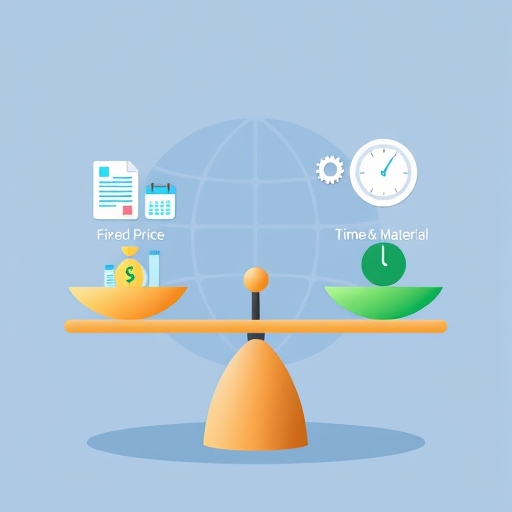
Offshoring or Outsourcing has become prevalent in companies that want to reduce costs, access global talent, and focus on core business functions. And there are different challenges when companies think about offshoring, How to setup the offshoring? How to choose the right offshoring partner?
Among such deliberations is another important one, which is the right engagement model Fixed-Price Vs. Time & Material? There are a few other innovative models but these 2 are the major ones and others models are simply a variation of these two.
Each model has its pros and cons and is suited for a few use cases. It will be good to understand the nuances of these two models which will then help save time and effort and would ensure the project’s success.
Fixed Price Model
In a Fixed Price engagement, the scope, timelines, and costs are predetermined or fixed. This model is easier and relies heavily on the service partner’s ability to deliver. The service provider delivers a project or service for a set price, within set timelines, with agreed scope, regardless of the effort involved.
When to Choose Fixed Price:
-
Defined Scope: If the project scope, requirements, and deliverables are well-defined and are not prone to change, the Fixed Price model works best. For example, creating a small website or implementing a well-documented software module.
-
Budget Constraints: When you have a strict budget constraint, this model can be the best as it will not incur any additional charges beyond the contracted cost.
-
Short-Term Projects: Fixed Price model is often best for short-term and timebound projects. The uncertainties in a short-term project are limited thus making it viable for both parties to engage in such a contract.
-
No In-house Expertise: If there is no in-house expertise to collaboratively develop, or review and you don’t want to add any internal management overhead this model works the best.
Pros:
- Clear visibility on end deliverables.
- No cost or management overheads.
- No in-house expertise needed
Cons:
- Less flexibility for changing requirements.
- Higher risk of scope misunderstandings.
- Quality concerns may arise as there is no review and less involvement from the client.
Time & Material Model
In a Time & Material engagement, you pay for the actual time and resources engaged in the project. This engagement model offers more flexibility, and control for the client and is based on hourly or daily rates for the vendor team members.
When to Choose Time & Material:
-
Evolving Requirements: If the project scope is unclear or expected to evolve over time, this model works well for this use case. For instance, the team develops a new product while gathering some requirements and working on others in parallel. Or requirements changes based on user feedback.
-
Long-Term Projects: Time & Material provides visibility into efforts and more control over their allocation for large, long-term, or support projects like software maintenance, SaaS development, or digital transformation initiatives.
-
Complex or Innovative Work: For work that involves more exploration, proof of concepts or dealing with a new technology, this model is more flexible and adaptive.
-
Collaborative Development: Many companies have their own product managers, architects, and a clear vision of how their product should be. They look for more hands to develop and test rather than end-to-end execution. The T&M model enables such collaborative development and product control.
Pros:
- Flexibility to change scope and priorities.
- Visibility on efforts and cost breakup.
- Allows for more control of the development process and re-prioritize.
Cons:
- Less cost predictability and risk of cost escalations.
- Requires active client involvement and the delivery risk is shared.
- The overhead of managing the offshore team with different work cultures.
Fixed Price Vs. Time & Material – When do they Fail?
Fixed Price
- Scope Changes: This is a very common issue with this engagement model. Usually, the team progressively discovers or understands the requirements well when a prototype or working model starts to take shape.
- Surprises towards the end: The client is less involved in this model and when the demos reveal the difference in understanding between client and vendor. These late surprises could delay the timelines
- Lack of Transparency: This model doesn’t offer transparency into efforts involved, cost breakdown, etc. When clear communication doesn’t flow from the vendor and sudden delays occur, it could be frustrating.
Time & Material
- Lack of Alignment: This is the biggest reason for T&M’s failure. This model sometimes could involve a lot of management overhead. The onsite and offshore teams must align with the project goals and deliverables. They must closely coordinate and collaborate to avoid working in silos.
- Micro-Management: If the customer starts micro-managing the project, it could hamper the productivity and ways of working of the offshore team. This can result in offshore teams completely offloading the responsibility.
- Cost Overruns: Without clear deliverables defined, the management might not get a clear picture on the ROI. The costs sometimes overrun in exploratory and research work or if the team does not properly monitor the offshore work.
Conclusion
Choosing between Fixed Price and Time & Material could be crucial not only for financial reasons but also as it may impact the project outcome and business goals. Therefore, carefully analyze your project’s requirements, constraints, and objectives before deciding on the model. Whichever model you choose, steer clear of the failure reasons for minimizing risks and maximizing value.
By understanding these models and their respective pros and cons, companies can make informed decisions, setting the foundation for a successful offshore partnership.